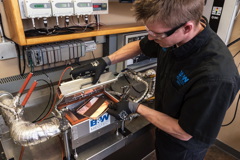B&W MEGTEC Launches Drying Lab
- Published: August 02, 2017
DE PERE, WI | Babcock & Wilcox MEGTEC has developed an exclusive in-house drying lab with a bench-top system for capturing the drying behavior of coatings on web-based substrates using small-size samples approximately 5 x 5 in. Located in the Development Center at headquarters in De Pere, the drying lab allows researchers to qualitatively and quantitatively observe drying characteristics critical to early scale-up steps in coating formulation development, dryer optimization, and overall process troubleshooting.

“In parallel with the development of new coatings, researchers often need to define a method or process for proper drying,” says Steve Zagar, chief engineer for the B&W MEGTEC thermal products group. “But in the early development stages, advanced materials are often available in limited quantities, which can make traditional pilot-scale coating and drying trials impractical.
“Using smaller-scale samples, our new drying lab captures key information that’s vital for guiding timely process design decisions. The goal is to leverage early returns on key data to help assess the commercial viability of web-based substrates before making extensive development expenditures in time and capital.”
The new bench-top laboratory system enables the company’s process engineers to track rates of evaporation for water and organic solvents, along with determining the drying time required to reach target solvent or moisture residuals in the coated substrate. The drying performance capabilities of the lab enable researchers to do the following:
- Obtain more detailed information compared to data generated by a lab batch oven.
- Observe and record quantitative drying data about the coating.
- Simulate continuous process drying conditions.
“These laboratory methods make it possible to leverage early returns on key data to help assess the commercial viability of web-based substrates,” Zagar says. “The design and selection of candidate drying methods we’re able to make early in the development of new coatings can help assess commercial viability of scale-up to production.”
The lab also allows research engineers to capture the complete drying characteristics of coatings and substrates using small samples. Additional capabilities include the following:
- Qualitative, semi-quantitative, and even precise drying measurements suitable for early research work
- Enhanced coating formulation development work that requires relatively small sample amounts to conduct experiments
- Analyses and troubleshooting of drying issues on existing processes, with the added benefit of conducting work off-line and with reduced material requirements.







